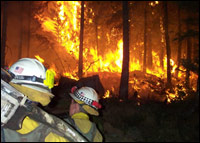At the end of summer in southern Oregon’s Cascade foothills, when trees and brush have turned tinder dry and thunderstorms regularly roll overhead, Millie Chatterton and her neighbors start thinking about the lightning strike that could touch off disaster.
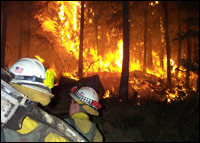
The Biscuit burns in 2002.
Photo: USFWS.
Chatterton can’t forget the afternoon in 1987 when she walked out of a grocery store in her town, Cave Junction, and saw a “big atomic mushroom cloud” of smoke blossoming on the horizon. Later, she watched the lightning-caused wildfire “blowing up trees one after another” on federal property near her own five acres. That fire, which scorched 150,000 acres of land in Oregon and California, came within six miles of Chatterton’s house. In 2002, the notorious Biscuit fire, also started by lightning, came even closer, roaring within a mile of her land as it torched 500,000 acres.
After each close call, Chatterton — who is retired and gets by on a set income — looked for help to reduce the fire threat on her property. This meant thinning Douglas firs and black oaks, and getting rid of excess brush. The work is not easy, or inexpensive: the most recent bill was $3,000. Without grants from Oregon’s Department of Forestry and a local nonprofit, Chatterton says she would not have been able to afford that. Most of her neighbors, all longtime residents, face similar financial burdens.
In recent years, the federal government has set aside funding for community outreach and hazardous fuels reduction in fire-prone areas. But it may not be reaching the people it’s intended to help. A new study by Eugene, Ore.-based Resource Innovations shows that low-income households and communities in wildland areas, typically at the highest risk for wildfire damage, are often overlooked when it comes to funding. Around the West, there is growing concern that poor, at-risk areas are slipping through the cracks.
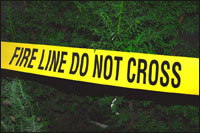
Whose line is it, anyway?
Photo: iStockphoto.
Fanning the Flames
In the summer of 2000, wildfires burned 8.4 million acres in the West, nearly double the 10-year annual average of 4.9 million acres. That spurred Congress to approve a 10-year, $1.8 billion National Fire Plan to protect forests through better firefighting and management, as well as community outreach. The plan brought hope that communities like Chatterton’s would receive financial and technical support, and in some cases basic safety education. (In December 2003, after another round of monstrous wildfires, the controversial Healthy Forests Restoration Act was signed into law, also ostensibly to reduce high levels of hazardous fuels on public lands.)
The cost of fighting wildfires is enormous — the Biscuit fire required $153 million in suppression costs alone — but for people whose homes and lives are destroyed, the losses are incalculable. A 2003 study on natural disasters in the U.S. over the past 20 years found that social class plays a role in how people are affected by disaster on many levels, from preparation to emergency aid. Those who have fewer resources to prepare for or recover from disasters — like many New Orleans residents — will be affected for years to come.
A 2001 report by Resource Innovations — a precursor to its more recent research — found that wildfires have a greater impact on poor people than other community members. Rural, low-income households are often located far from help. A breadwinner working two jobs probably doesn’t have time to get to volunteer fire training or clear brush, never mind apply for a brush-clearing grant. A homeowner or renter may not be able to afford insurance, or have the capital to recover from a catastrophic loss. And some people in rural areas don’t want help, don’t want to be disturbed, and don’t want any contact with the government. As Oshana Catranides — director of the Lomakatsi Restoration Project, the nonprofit that assisted Chatterton — puts it, “People live out here because they like their privacy.”
Further complicating the issue, a rush throughout the West to buy property close to the woods is changing rural economics. On the one hand, new homes near wildlands — in the so-called wildland-urban interface — can heighten awareness of the need for protection. On the other, these homes tend to hog the spotlight — look no further than your TV screen, as camera crews zero in on flames licking at mansions. While wealthy homeowners tend to have insurance and be aware of funding opportunities, their closest neighbors may not.
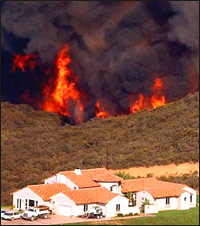
Too close for comfort in California.
Photo: USHRC.
Mark Sorensen has seen this odd juxtaposition up close. Sorensen directs the General Services Department for Josephine County, Ore., home to Cave Junction. A flood of retirees and second-home builders has created neighborhoods with “a generation or two in a mobile home, then a road next to it and a million-dollar home,” he says.
In one of dozens of planning meetings the county held in 2003 while developing a master plan for natural disasters, Sorensen recalls, someone asked, “What are you doing for people who can’t take care of themselves in an emergency?” The moment was a wake-up call for the former state legislator and school administrator, who saw that the needs of senior citizens and low-income residents were not being considered.
Increasingly, emergency planners who develop wildfire strategies at the local, regional, and national levels are realizing that knowing exactly who is at risk and where they live is critical. While millions of research dollars have gone to ecological studies of wildfire, until recently no one had looked at the relationships between wildfire, poverty, and federal funding.
Who’s at Risk?
For Kathy Lynn, associate director of Resource Innovations, the 2001 report on poverty and wildfire was just the beginning. The next question was obvious: “Where are the poor communities at risk to wildfire, and can we tell if they are receiving assistance, both financial and technical?” She set out to find the answer, along with partners from the U.S. Forest Service and the National Network of Forest Practitioners.
For its latest study, the team created a series of maps that overlay wildland-urban interface areas, federal forest boundaries, and low-income communities across the country. For some states, they were able to go a step further and map the organizations and agencies that received grants. They then plotted a relationship that had long been suspected, but never formally documented: a disproportionate number of poor households in wildland areas may not be considered for funding because they fall outside the wildland-urban interface boundary — that is to say, way out in the woods.
The National Fire Plan grants distributed by the Forest Service and Department of the Interior range from a few hundred to a few thousand dollars, and can require the applicant to match 10 percent of their own money or in-kind services. Last year, the NFP provided $58 million, and has doled out $445 million since its inception. But there is no mechanism to track whether the funding is going to the people most in need of support.
“This [study] is sort of the social and economic component to ecological risk,” explains Wendy Gerlitz, director of projects for NNFP. The team was stopped in its tracks, however, by a lack of information: there is no nationwide demographic, social, and economic data specifically focused on communities at risk for wildfire.
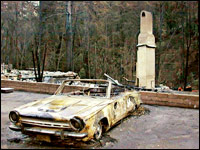
An unfathomable loss.
Photo: USHRC.
At a local level, it’s fairly easy to measure a community’s ability to protect itself, known as “community capacity”: count up the volunteer firefighters, the number of meetings about wildfire preparedness, and the healthy businesses in town, and roughly estimate how much assistance, pre- and post-fire, is needed. Without this vital information on a national scale, Lynn and Gerlitz say, it’s difficult to know exactly who is at risk, where they live, and what kind of help they’re getting from federal agencies.
The two hope the map’s accessibility will expand awareness of this issue and prompt changes. In November, they met with leaders from the Forest Service, the Bureau of Indian Affairs, and the Bureau of Land Management. They received positive feedback, but the reality of the current budget climate means there are precious few dollars to implement new policy and make significant changes to existing programs.
Bonnie Wood, the National Fire Plan’s executive director for the Northwest region, says the new study “enlightened a lot of people. Kathy went through a methodology that is really well-founded, and she was able to describe to a number of audiences at my level, and higher, how are we considering those lower economic folks?”
Wood’s own “aha” moment came when she was in the field in Oregon to oversee fuel-reduction grants. She visited a wealthy suburb that had won a grant with no matching requirement, and realized a poor community in the same county had been offered the same grant — if they matched funds.
“It’s one the bureaucrats didn’t mean to miss, but we just missed it,” Wood acknowledged. “We were saying, ‘You can have $350 if you spend $350.’ But another community didn’t have to match because they had a well-educated grant writer. They got kind of a free ride.” With the new information available, Wood says, this is far less likely to happen.
Say It and Spray It
While the mapping team and others in the fire-protection community work to improve the distribution of federal funds, another government program intended to help communities cope has just been cut.
The Economic Action Program, created in the 1990s, funded technical assistance, job retraining, and education programs to help forest communities contend with the downturn in the logging industry. Congressional spending on the EAP has declined from $12.5 million in 2002 to zero — no funding was provided in the fiscal year 2006 budget.
Among community forestry experts, there is a sense of resigned frustration that a federal program with such a concentrated focus is being phased out. EAP grants helped forest communities reduce fire risk by building the infrastructure to turn raw, hazardous material — small-diameter trees of no commercial logging value — into furniture, hardwood flooring, or biomass. Retraining programs helped employ local citizens and keep communities economically intact.
Susan Odell, a U.S. Forest Service coordinator who provided technical assistance on the mapping project, ran the program that administered the EAP grants. “Some people think we should have less federal engagement in this kind of stuff,” notes Odell, who has worked on community forestry issues since 1991, and for the Forest Service for more than 30 years. Despite her disappointment in EAP’s fate, she says the Forest Service has a long history of local engagement, which she expects will continue.
Odell also takes heart that the new findings about poverty and funding are inspiring dialogue. “I think it helps people who are used to talking about the biological and ecological situation see that they can learn and talk about social and economic issues in terms they can deal with,” Odell said. “That’s a big step for people with a lot of background in forestry or soil science.”
Lynn — who now hopes to undertake a community-level study demonstrating how data about wildfire and poverty can be produced and replicated — says the events surrounding Hurricane Katrina have brought a new focus to the issue. The collision of poverty and natural disasters “wasn’t something people thought about on a day-to-day basis,” she says. “But now, with Katrina, it’s absolutely magnified the impact on the poor, disabled, underserved communities, and how we help the communities with the least resources.”
This year, wildfires have already taken hold in Texas, Oklahoma, Arizona, and California, and meteorologists are forecasting a high fire season. As community leaders gear up for more battles on the ground, they are stressing partnership over partisanship, hoping the feds will come through for the people who need them most.
Click here to read about a California group that’s working to keep community members safe from wildfire.
